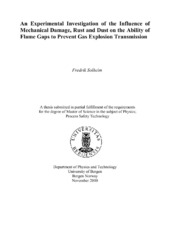| dc.description.abstract | Potential ignition sources, such as motors, light switchers and relays that are located in an industrial area where an explosive atmosphere is a threat, must be designed in such a way that the ignition source does not ignite the hazardous atmosphere. Flameproof enclosures designed for electrical apparatus are constructed in such a way that the enclosure can withstand an internal explosion, without causing an external ignition of the explosive atmosphere. All holes and gaps on the enclosure are designed in accuracy to given requirements from international standards. Current international standard (IEC 2007a) require that the maximal average roughness (Ra) of a flame gap surface is ≤ 6.3 µm. The standard also requires that any damaged flame gap must be brought back to its original state. No technical argument is given by the current standard (IEC) to justify the requirements of an average roughness ≤ 6.3 µm. In the present work it is applied severe damages on different flame gap surfaces. This involves highly rusted flame gap surfaces and flame gap surfaces with different perforating grooves over the entire length. The purpose of the experimental work has been to investigate how different damages on the flame gap surface affect their ability to prevent ignition of an external explosive gas mixture. The international standard (IEC 2007a) also requires a maximum allowed gap opening/distance between the two joints that form the flame gap. This distance varies with the inner volume of the flameproof enclosure and the width of the two joints. For the experimental set up in the present work the maximum allowed gap opening is 0.40 mm. This gap opening contains a safety factor, which implies that the actual distance between the joints can be noticeably larger without causing a re-ignition of an external gas mixture. The largest width between the joints in a standardized test apparatus, which prevents transmission of a gas explosion on the inside of the gap to the outside of the gap, is denoted as the MESG value (Maximum Experimental Safe Gap). This value is used in the present work as a parameter for judging if different damage on the gap surface reduce or improve the gap's ability to prevent a re-ignition. Flameproof enclosures are located in areas where an explosive gas/air mixture can be formed. Dust is represented in almost any atmosphere and many types of dust are combustible. In the present work it has been investigated how the presence of dust inside a flameproof enclosure impacts the flame gaps ability to prevent a transmission of a gas explosion. The dust was not placed in the internal chamber, but sprinkled into the flame gap. This was to assure that the dust possibly found its way into the internal chamber by itself. The purpose of this work has been to investigate if dust can ignite inside the flame gap or the inner chamber, during an internal gas explosion and subsequently penetrate at a burning state into the external chamber and cause a re-ignition. To assure that the gas did not cause the possible re-ignition, the gap opening was set to a width smaller than the respective MESG value for an undamaged slit. It is performed experiments where the gap opening is set to the allowed width of 0.40 mm for flameproof enclosures, given by the standard (IEC 2007a). The apparatus used in the experimental work was mainly the Plane Rectangular Slit Apparatus (PRSA), but... | en_US |
